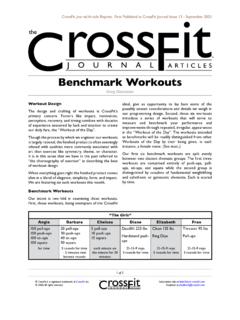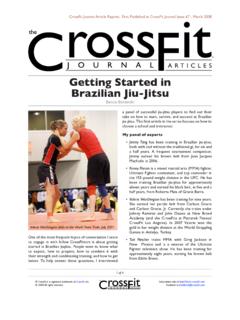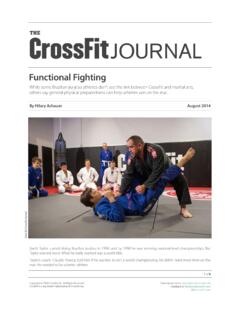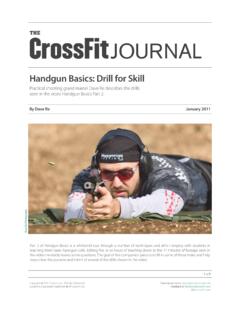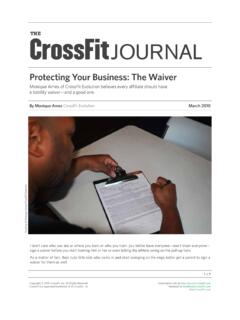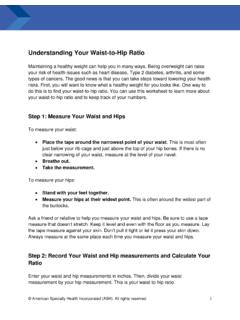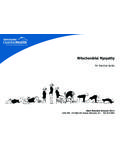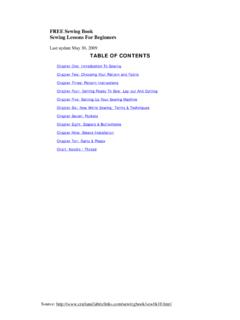Transcription of Getting Some Leverage
1 Getting some Leverage Paying attention to simple mechanics can help great coaches improve technique and get better results in the CrossFit box. By Dr. Lon Kilgore May 2010. Staff/CrossFit Journal The human body is a complex system of levers that enables us to perform everything from very basic to extremely complex movements. Individually, levers are simple machines, and we can think of the body as a collection of machines. Bones are the rigid frame part of the lever machine through which force is transferred. The joints of the body provide 1 of 6. Copyright 2010 CrossFit, Inc. All Rights Reserved.
2 Subscription info at CrossFit is a registered trademark of CrossFit, Inc. Feedback to Visit Leverage .. (continued). the axes around which rotation occurs. The muscles It may not be immediately apparent why any of this generate the force (or tension) needed to cause overt really matters but it does. The squat, for example, is movement. An intermediary and important structure accomplished by a collection of levers, and something here is the tendon. Because force produced by a muscle is as simple as placing the bar high on the traps or low transmitted to the bone via tendon, tendons are crucial to across the scapular spines alters moment arms and joint human movement.
3 Angles. Subtle changes in the system alter the nature of the forces generated and experienced by the body and Levers and Lifting Weights therefore affect, for good or bad, the nature of adaptation In the human body, all three possible types of lever are the exercise will produce. If we introduce inappropriate represented anatomically (this is arguable, as one type lever configurations or inadvertently create extra lever requires special circumstances to be present; see Gray's arms, we create poor technique, poor force transference Anatomy reference below). When classifying levers we and poor fitness results.
4 We have to learn how to recognize need to consider the following entities to assess a lever levers in order to be able to reinforce good technique and system by type: eliminate bad. The point of force application (F) the site of muscle First-Class Levers attachment and action. First-class levers are the most efficient and probably the The point of resistance application (R) the site of the most identifiable: they look like a teeter-totter (Figure load to be moved. 1). In fact, the use of this type lever is extremely well documented throughout human history, and in 200 The fulcrum or axis of rotation (A) the joint to be Archimedes famously said, Give me a place to stand and a flexed or extended.
5 Lever long enough and I will move the world.. When these three entities are laid out linearly, the space With a first-class lever, the axis or fulcrum always lies between the point of resistance application and the axis between the force and resistance (F-A-R). A first-class lever (fulcrum) is called the resistance arm. Similarly, the space can perform all four basic machine functions: (1) balance between the point of force application and the axis is forces, (2) change direction of the force applied, (3) modify called the force arm. (increase amplify) the force applied, and (4) modify the speed and or range of motion.
6 This is a good point to introduce the concept of mechanical advantage. Think of a teeter-totter, exactly 10 feet long end-to-end, with the fulcrum at dead center and a 50-lb. kid on each end. What will happen if they just sit there? Right. Nothing. The forces are balanced, and without If we introduce inappropriate a little leg push from one of the kids no one goes up or lever configurations down. Now think about when you were a kid and how or inadvertently create hard you had to push to go up. Not very hard. That's the lever system giving you a little advantage. Putting this into extra lever arms, we create an anatomical perspective, the same situation is present poor technique, poor force where the skull sits atop the cervical vertebrae.
7 How hard do you have to work to tilt your head from side to side or transference and poor from front to back? fitness results. What happens if you move the teeter-totter's fulcrum to a point where one arm is 4 feet long and the other is 6. feet long? Which side has an advantage? Well, if you draw the short arm, you are only along for the ride. The moment around the axis of rotation (fulcrum) is a product of the force applied and the distance from the force to the axis. 2 of 6. Copyright 2010 CrossFit, Inc. All Rights Reserved. Subscription info at CrossFit is a registered trademark of CrossFit, Inc.
8 Feedback to Visit Leverage .. (continued). Dr. Lon Kilgore Figure 1: An example of a first-class lever causing a lateral tilt of the head (anterior view). Force = neck-muscle contraction, Axis = atlas vertebrae, and Resistance = weight of head. The size of the arrow indicates the relative magnitude of muscular force exerted. Simple math tells us that the shorter arm is at a disad- Dr. Lon Kilgore vantage. That means the kid on the long arm can keep the kid on the short arm up in the air as long as he wants. It also means that to balance the force to where the asymmetric teeter-totter works as desired, a heavier kid needs to be on the short arm.
9 Second-Class Levers With a second-class lever, the resistance is in the middle, between the axis and fulcrum (F-R-A). The most easily identified example of this class of lever is the wheelbarrow. Figure 2: An example of a second-class lever in exercise is In this arrangement the force arm is always longer than the push-up, where the body is pushed up by the upper-body the resistance arm, and this favors force production. Henry musculature as it rotates around the ball of the foot on the Gray, writing in the Myology Section of Gray's Anatomy, floor. Force = arm-muscle contraction, Resistance = body said there are no second-class levers occurring in the weight, Axis = ball of the foot.
10 Body. In an unweighted human producing unresisted joint movement in the lab, this is true. However, in sport This system provides a good reason to know where and exercise we can find several examples of the body as muscles attach at both ends because that knowledge a whole acting as a second-class lever. An easy example is will aid in understanding physically how muscles work. the push-up (Figure 2). Human-implement interactions also provide examples of third-class levers. A baseball bat is a good example of a Third-Class Levers third-class lever. The spatial arrangement of lever elements The third-class lever is the most common type of lever in in this class results in a mechanical advantage biased the human body.
